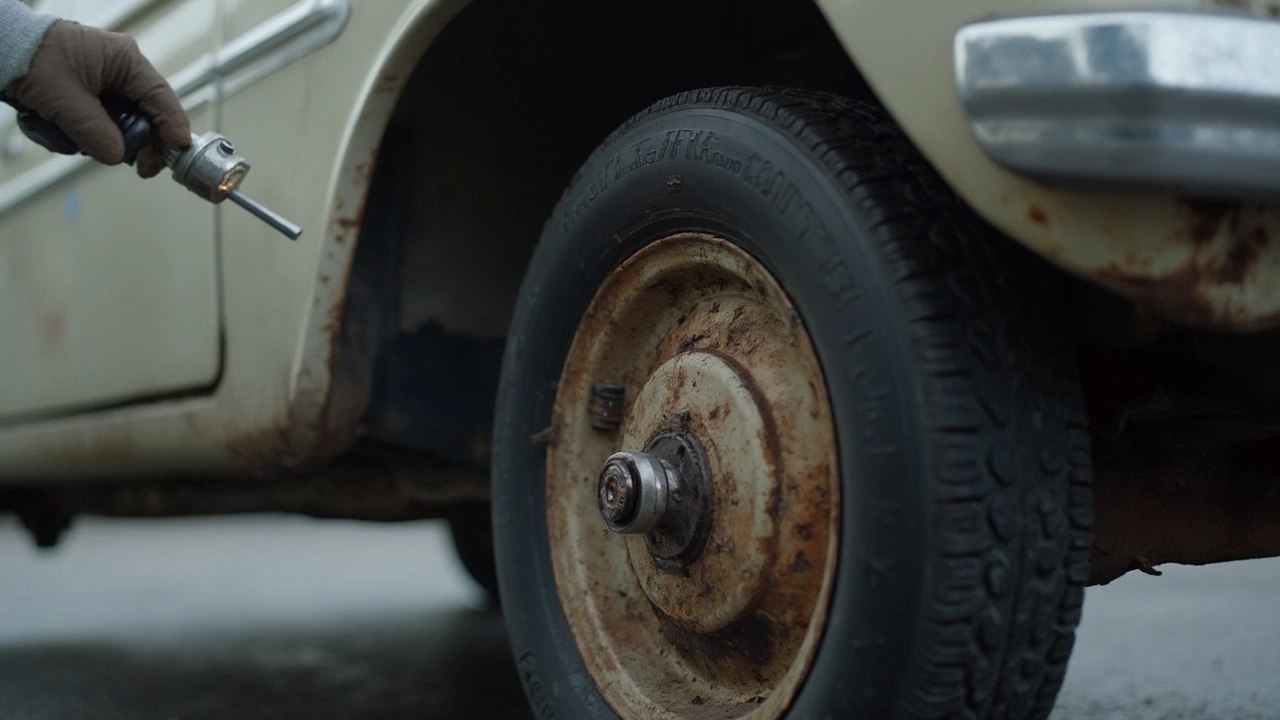You hit a bump, and your car bounces like a trampoline. Or maybe you’ve noticed a weird clunk when you turn, or your steering feels loose and floaty. Ever wondered if you can just keep driving like that? Here’s the deal: suspension issues don’t just make your ride uncomfortable—they mess with how safe your car is, especially when you need it most.
The suspension isn’t just about keeping things smooth for your coffee cup. It’s the reason your car actually sticks to the road when you hit a corner or have to dodge an unexpected pothole. When something’s off—like worn shocks, broken struts, or saggy springs—you’re gambling with your ability to stop fast, steer straight, or even avoid a crash. Most people don’t realize just how much is riding on those under-the-car parts until they’re bouncing, squeaking, or sliding all over the place.
If you think your suspension might be shot, stick around. You’ll want to know what to check, what happens if you ignore the warning signs, and how you can get things sorted before things get expensive or dangerous. I’ll walk you through what you need to know—without any shop jargon or scare tactics—just the stuff that keeps you and your ride safe.
- Spotting Bad Suspension—What It Really Looks Like
- What Could Go Wrong? Real Risks Behind the Wheel
- Why Ignoring Suspension Trouble Costs More
- Getting Back on Track—Fixes That Make Sense
Spotting Bad Suspension—What It Really Looks Like
Most folks don’t realize right away that their car safety and handling are going downhill, thanks to bad suspension. It’s easy to blame weird noises or bumpy rides on rough roads, but your suspension parts are usually calling for help.
If you’re hearing more rattles than Rover shaking after a bath, pay attention. Some warning signs are dead simple to spot. Here’s what to watch for:
- Bumpy or shaky rides, even on smooth pavement
- Loud clunks, squeaks, or grinding sounds over bumps
- Uneven tire wear—almost like the tread’s been chewed on one side
- Leaning, nose-diving, or rolling way more than usual in turns or when you stop
- Steering feels loose, or the wheel pulls one way
- Car sits lower on one side, or you see oily smudges near the wheels (that’s fluid leaking out of worn struts or shocks)
One study from the National Highway Traffic Safety Administration found that suspension issues played a role in about 13% of single-vehicle crashes where a car ran off the road. That’s not a number you want to ignore.
If you’re not sure whether it’s bad suspension, try the good old bounce test: press down hard on the front or rear of your car, let go, and count the bounces. If it goes up and down more than twice, odds are your shocks need help.
“Your steering and braking can be badly affected by worn suspension, so it’s smart not to brush off odd noises or changes in the way your vehicle feels.”
— AAA Car Care Council
Catching these signs early saves money—and keeps you from becoming a crazy story in someone’s group chat. Don’t shrug off even small changes in steering, ride height, or noises. They’re your car’s way of begging for help before something fails at the worst possible moment.
What Could Go Wrong? Real Risks Behind the Wheel
If you keep driving with bad suspension, it’s not just about feeling every crack in the road—it’s about handling, safety, and the actual health of your car. Your suspension parts keep your tires planted where they need to be. When they can’t do that, a lot can go sideways fast.
Here’s what’s really at stake when you ignore suspension trouble:
- Loss of Control: Worn shocks and struts make your car feel loose, especially on turns or when you need to swerve. One sharp move and your car might not respond the way you expect. That’s a real risk in rain, snow, or even just avoiding some roadkill.
- Longer Stopping Distances: A busted suspension makes your car nose-dive or bounce when braking. According to the National Highway Traffic Safety Administration, cars with bad shocks can take nearly 20% longer to stop in emergencies. That’s the difference between a near-miss and a collision.
- Tire Damage: Bad suspension leads to uneven tire wear. You’ll see bald spots or edges wearing out fast. Not only do tires get expensive, but sketchy grip can send you sliding, especially on wet roads.
- Steering Problems: If it feels like you’re always correcting the steering wheel, your suspension isn’t keeping things steady. That pull or drift means you need to fight the car to keep it in your lane—a clear sign something’s wrong.
- Extra Wear on Other Parts: Bad suspension parts make your whole car work harder. That means more visits to the mechanic, and not just for the suspension—think ball joints, wheel bearings, even your brakes.
Check out just how much risk ramps up as suspension gets worse:
| Suspension Issue | Common Outcome | Risk Factor |
|---|---|---|
| Worn Shocks | Longer stops | Increased braking distance |
| Broken Springs | Bumpy ride, noise | Loss of control in turns |
| Leaking Struts | Poor grip | Hydroplaning risk |
| Bent Control Arms | Misaligned steering | Drifting, increased tire wear |
So, while that wobble or bounce might seem harmless now, every drive with bad suspension is a gamble. Cars are a lot like dogs, honestly—ignore the signs, and sooner or later, you’re in for a nasty surprise.

Why Ignoring Suspension Trouble Costs More
Putting off repairs for your bad suspension isn’t just risky—it hits your wallet harder in the long run. If you keep driving with worn suspension parts, your car forces other components to pick up the slack. That quickly turns a simple shock absorber fix into way bigger bills.
For example, a busted strut or worn-out shocks messes up your wheel alignment. This chews up your tires fast, and uneven tires aren’t just noisy—they’re dangerous. New tires aren’t cheap, and you’ll need them long before you planned if your suspension isn’t working right. And here's another kicker: steering components, like tie rods and control arms, wear out way quicker because of all that extra bouncing and shaking.
Here’s what you might end up paying if you ignore suspension issues:
| Ignored Problem | Extra Repairs Needed | Estimated Extra Cost (USD) |
|---|---|---|
| Worn Shocks/Struts | New Tires, Alignment | + $700 |
| Bent Control Arm | Suspension, Steering Parts | + $500 |
| Cracked Spring | Axle, Brake Damage | + $900 |
Not only does it cost more, but you’re gambling with your safety. Your stopping distance could get 20% longer with blown shocks, according to real-world brake testing. That’s the difference between a close call and a crash. If you’re ever in an accident and insurance finds out you ignored obvious suspension wear, there’s a chance your claim gets denied.
If you hear banging, squeaks, or feel extra bouncing, get it checked out. Fixing early is way cheaper than repairing the ripple effect across your whole car. Think of it like spending $250 now to avoid a $1,000 bill (plus a whole lot of headache) down the road.
Getting Back on Track—Fixes That Make Sense
Alright, you’ve spotted the signs of bad suspension—now what? Fixing these issues doesn't have to be scary or mysterious. The first step is getting your car checked by a trusted mechanic, but don't feel pressured to rush to the most expensive shop on the block. Plenty of decent garages can do a straight-up check for busted suspension parts like shocks, struts, bushings, or control arms.
If you’re handy with a wrench, you might tackle things yourself. For the rest of us, here’s the usual game plan when it comes to sorting out suspension problems:
- Shocks and struts—When they’re worn out, you’ll notice bouncy rides and longer stopping distances. Swapping in new ones can make your car feel brand new and improve car safety big time.
- Ball joints, bushings, and control arms—Don't shrug off these little parts. If they're worn, you’ll get weird noises or handling that feels loose. They’re not big-ticket items to fix, but ignoring them makes bigger problems down the line.
- Springs—Saggy, broken, or rusted springs will mess with vehicle height and steering. Replacing them helps with vehicle handling and gets everything sitting right again.
You might be tempted to save cash by swapping out just one worn part, but suspension works best when things are done in pairs (or all fours). That means if one front shock is dead, do both fronts. It keeps things balanced and keeps driving risks low.
Thinking about the numbers? Here’s a simple breakdown of average replacement costs so you aren’t blindsided:
| Part | Average Cost (Parts + Labor) |
|---|---|
| Shocks or Struts (per pair) | $400–$800 |
| Control Arms or Ball Joints (each) | $150–$350 |
| Springs (each) | $200–$350 |
If you’re driving an older car or something with tricky parts, costs might go up a bit. But fixing your suspension beats ending up in a ditch or wearing out your tires far too early. To really drive home the point: healthy suspension parts keep your wheels steady, your family safe, and your repair bills sane.
Once everything’s sorted, pay attention to how different your car feels. Better handling, no weird clunks, and solid car safety—not a bad trade for fixing what’s under your ride.

